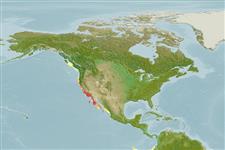Environment: milieu / climate zone / depth range / distribution range
Ecologia
marino demersale; distribuzione batimetrica 4 - 450 m (Ref. 96339), usually 55 - 244 m (Ref. 96339). Subtropical
Eastern Pacific: southern Oregon, USA to central Baja California, Mexico.
Size / Peso / Age
Maturity: Lm ? range ? - ? cm
Max length : 25.0 cm TL maschio/sesso non determinato; (Ref. 2850)
Mostly found on mud bottom from 55-244 m depth. Polychaete worms appear to be the preferred food, but euphausiids, amphipods, and fish eggs have been found in their stomachs (Ref. 4525).
Life cycle and mating behavior
Maturities | Riproduzione | Spawnings | Egg(s) | Fecundities | Larve
Eschmeyer, W.N., E.S. Herald and H. Hammann, 1983. A field guide to Pacific coast fishes of North America. Boston (MA, USA): Houghton Mifflin Company. xii+336 p. (Ref. 2850)
IUCN Red List Status (Ref. 130435)
Threat to humans
Harmless
Human uses
Strumenti
Special reports
Download XML
Fonti Internet
Estimates based on models
Preferred temperature (Ref.
123201): 8.1 - 16.7, mean 10.8 °C (based on 36 cells).
Phylogenetic diversity index (Ref.
82804): PD
50 = 0.7502 [Uniqueness, from 0.5 = low to 2.0 = high].
Bayesian length-weight: a=0.00380 (0.00147 - 0.00981), b=3.15 (2.92 - 3.38), in cm total length, based on LWR estimates for this (Sub)family-body shape (Ref.
93245).
Trophic level (Ref.
69278): 3.4 ±0.40 se; based on food items.
Generation time: 4.1 ( na - na) years. Estimated as median ln(3)/K based on 1
growth studies.
Resilienza (Ref.
120179): Medio, tempo minimo di raddoppiamento della popolazione 1.4 - 4.4 anni (K=0.27).
Fishing Vulnerability (Ref.
59153): Moderate vulnerability (37 of 100).
